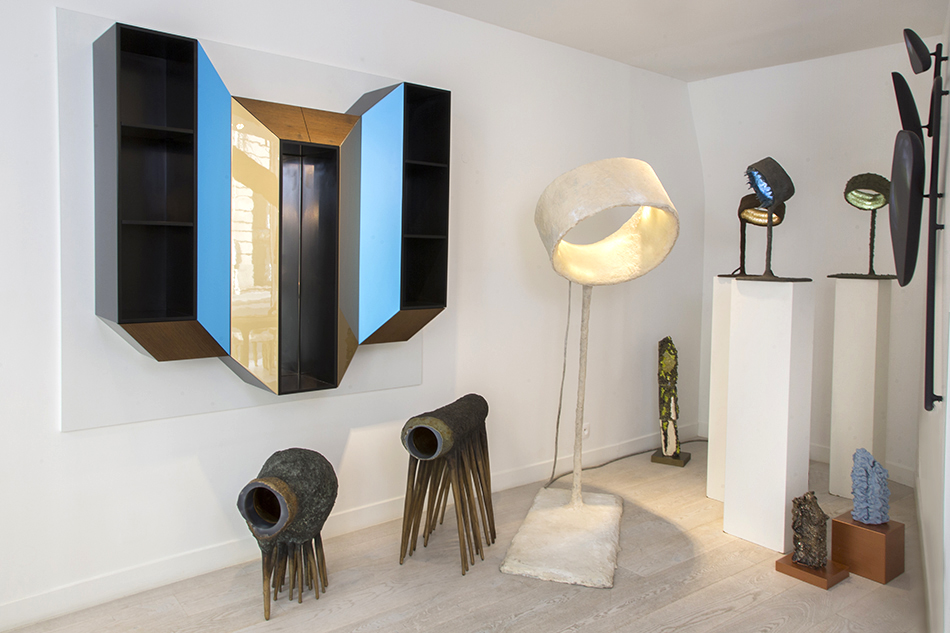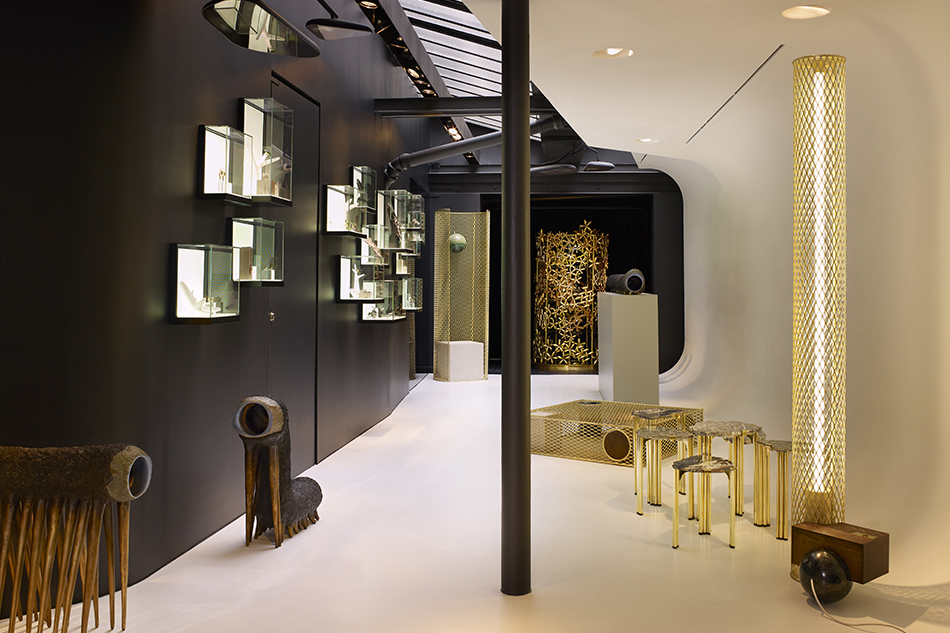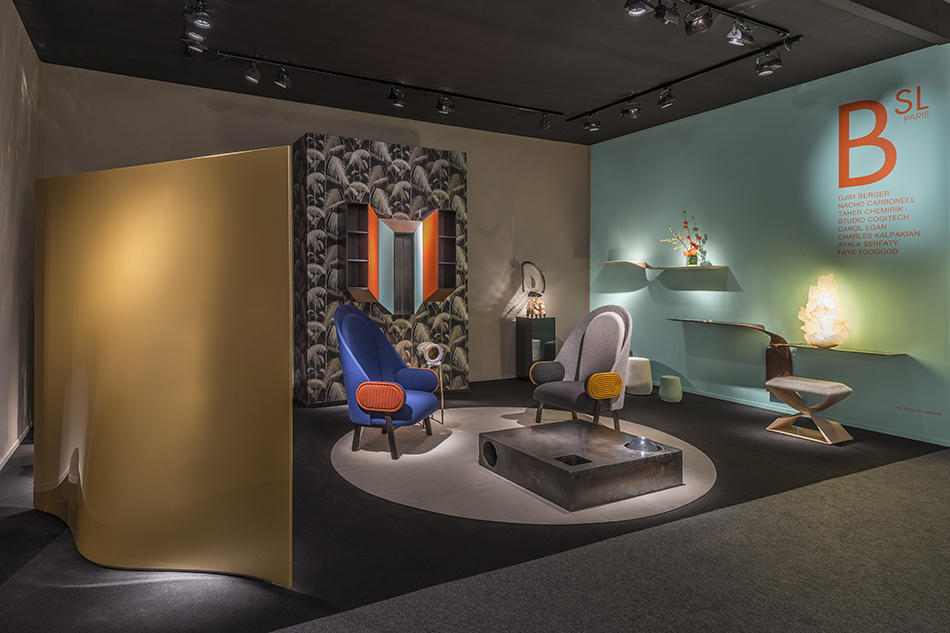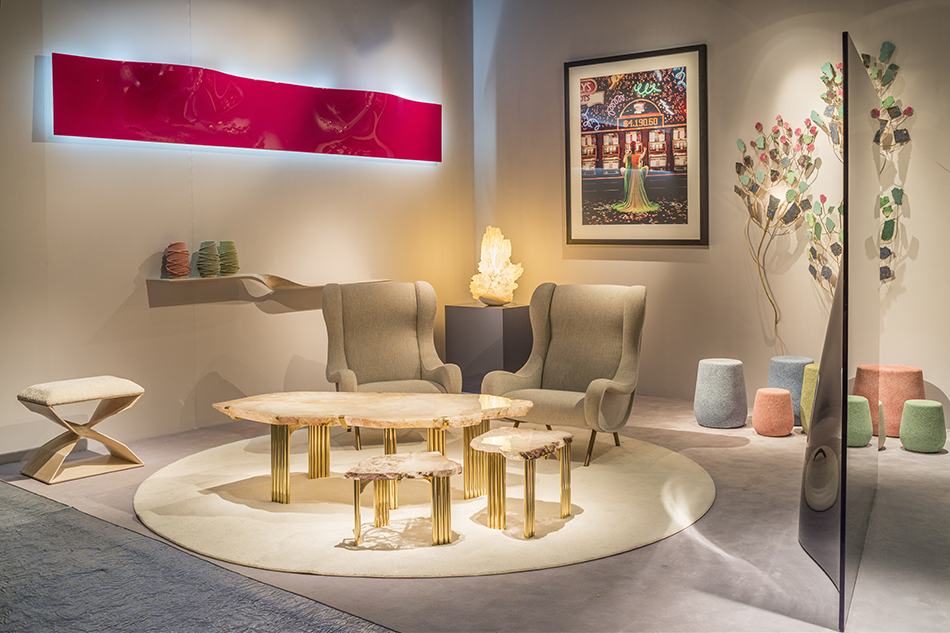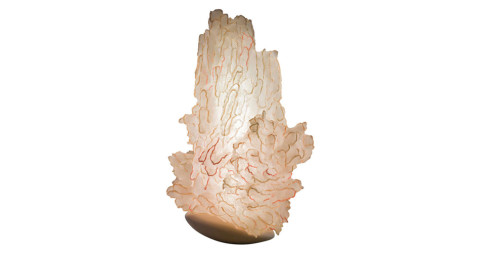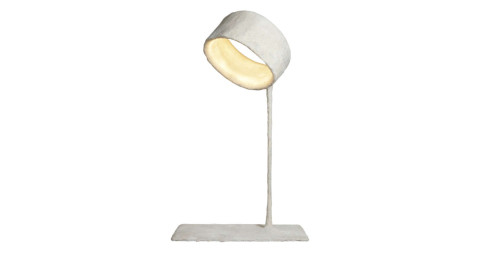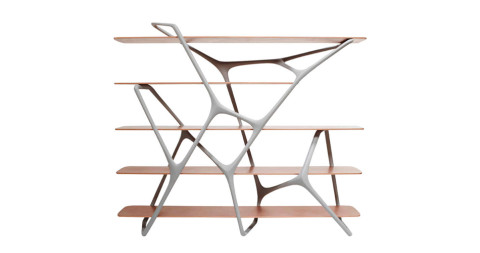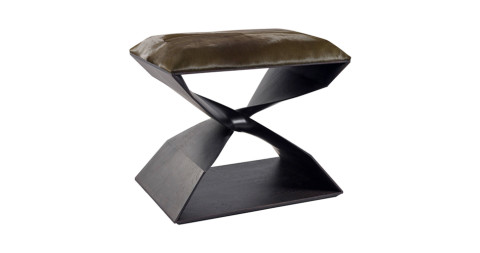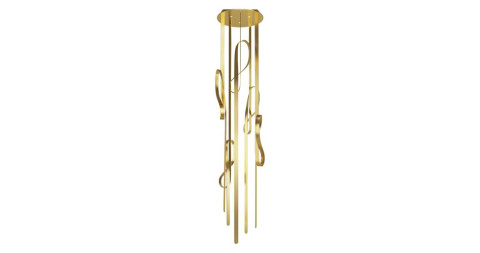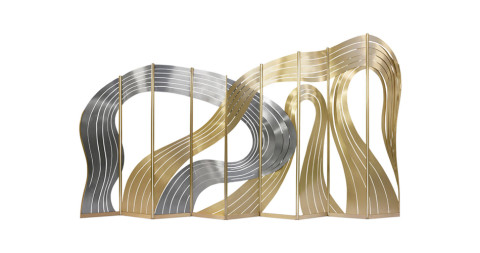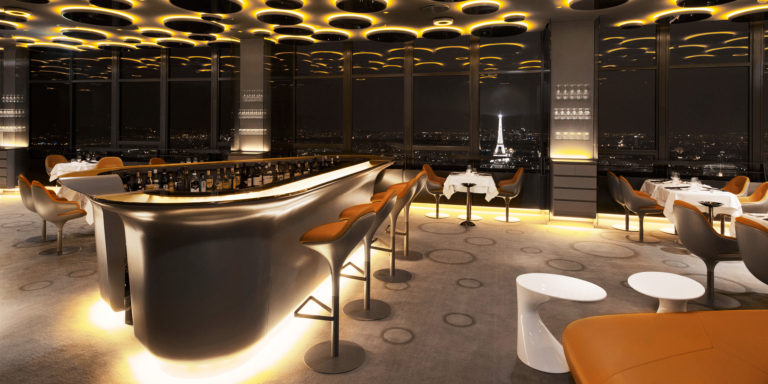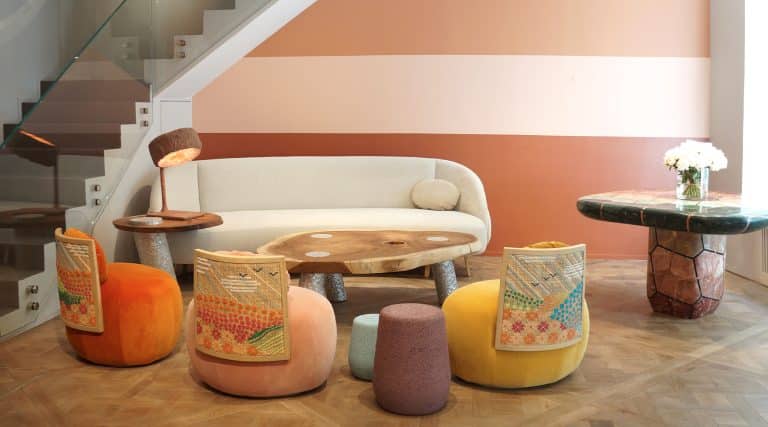
October 12, 2015In 2010, after several years working in communications (with a focus on the visual arts), Béatrice Saint-Laurent enlisted the help of Noé Duchaufour-Lawrance to design the interiors of her first BSL gallery space, in the Haut Marais neighborhood of Paris (portrait by Bertrand Corbara). Top: Galerie BSL’s location in the Marais. All photos courtesy of Galerie BSL, unless otherwise noted
Some of the coolest Parisians hail far from the Eiffel Tower’s iconic sparkle. A perfect example is Béatrice Saint-Laurent, whose Galerie BSL — with showrooms in the Marais and in Saint-Germain-des-Prés — has broken new ground in the world of design art.
Although she was born and raised a great distance from the Paris art scene — in Tarbes, a town in the Haute Pyrénées, 20 minutes from Lourdes – she couldn’t have had a better preparation for her later success. Her architect father, Jean-Paul Saint-Laurent, designed the apartment building in which they lived and capped his career with the Tarbes-Lourdes-Pyrénées Airport. Her mother, Jacqueline, a successful entrepreneur, opened one of the first independent Leclerc supermarkets, in Tarbes, in 1959, which became the unlikely home of a renowned contemporary art and theater center, founded by Béatrice’s philosophy-professor uncle, Marc Bélit. “All the artists would come, and some of them would create works on the spot,” Saint-Laurent remembers. (One creative visionary not on her family tree is the fashion designer Yves Saint Laurent. “We’re not related,” she emphasizes. “Because I’ve never wanted to play on that, I named the gallery BSL.”)
At home, her parents were not collectors, but they had contemporary furniture: “Le Corbusier armchairs, Mies van der Rohe’s Barcelona chair, a Florence Knoll table and Shiro Kuramata, too,” she says. At age four, Saint-Laurent had her own kid-size Harry Bertoia Diamond chair. Birthday presents were often a contemporary painting or photograph.
After school, at the prestigious Institut d’Études Politiques de Paris, Saint-Laurent worked, variously, as the editor of contemporary visual arts communications at the Ministry of Culture, at a visual-arts PR agency and as a speechwriter for two French foreign ministers. By now an avid collector — of vintage lighting, contemporary paintings and photographs — the stylish, dynamic and determined blond-haired dealer settled on a personal mission: to open a contemporary design art gallery and awaken French minds to the exciting mix such a space could offer. In 2010, she asked French designer Noé Duchaufour-Lawrance to conceive the interiors of a place in the Haut (or upper) Marais neighborhood around the Picasso Museum. His dramatic solution was a striking swathe of white Corian that sweeps through the all-black space, in sharp contrast to the dicta of typical white-cube art galleries. He calls it a comet; she calls it a wave or a matrix.

Galerie BSL opened a second location on rue Bonaparte in Saint Germain des Prés in September of last year.
Saint-Laurent’s eclectic slate of avant-garde designers includes Nacho Carbonell, whose Luciferase standing lamp was inspired by light-producing deep-sea creatures and marine plants; Charles Kalpakian, with his trompe l’oeil Kinétisme wall cabinets; and Charlotte Cornaton, whose “Insomnio” collection of porcelain “book” lighting sculptures, made in a historic Jingdezhen, China, workshop, are produced using several ancient porcelain techniques.
While Saint-Laurent won’t name names, her A-list clients include celebrities, collectors, designers, interior architects and decorators. “Seventy percent of them are international: Americans, Russians, Lebanese,” she notes. Such visitors are the reason she opened the second gallery in September 2014 between the Seine and the École des Beaux-Arts on the rue Bonaparte in Saint-Germain-des-Prés, where three large windows beckon passersby to take a closer look at the treasures inside.
Recently, on the eve of the PAD London art and design fair, an important date on the BSL calendar, Saint-Laurent sat down with Introspective to explain why she went into design, where she discovered her roster of creators and how they collaborate.
Why did you choose to open a gallery devoted to design, rather than contemporary art, which has been a constant in your life since childhood?
There were fewer design galleries than art galleries and I saw an opportunity. What most interested me, however, was the idea of production, that I could play a stronger, more active part in the creation of objects. I liked the idea of working as a research laboratory, not only as an exhibition space, and being a part of the creative process in a constant dialogue with artists-designers about the unique pieces or very limited editions they would create exclusively for my gallery.

In the rue Bonaparte gallery, a Carol Egan sculptural mirror hangs above a Studio Cogitech Matrice 05 chair. At center is a Faye Toogood Caged Elements lamp, and mounted on the ceiling is Ayala Serfaty’s light sculpture.
Where did you find the designers, and how do you collaborate with them?
I found Dutch designer Djim Berger in the 2009 graduation projects exhibition of the design academy in Eindhoven, Holland, where I fell in love with his lightweight porcelain stools. I discovered Lebanese designer Charles Kalpakian’s wall-shelf experiments at Paris Design Week 2011. They explored the optical illusion of bi-stability — objects in two dimensions that look three dimensional — and flirt with the spirit of Vasarely. After seeing Spanish designer Nacho Carbonell’s “Evolution” collection at Design Miami/Basel in 2009, I gave him a book on sea creatures that live in the ocean depths and produce their own light. He had begun experimenting with epoxy resin and doing color tests. All this inspired the 2011 “Luciferase” collection of lighting sculptures, his first works incorporating light.
As for Studio Cogitech, I met them when they manufactured Noé Duchaufour-Lawrance’s Naturoscopie 2012 collection of eight pieces. The idea is to find people who are experimenting with materials and push their limits. Their long, slim Matrice 08 table for BSL, made of carbon fiber with a blue lapis lacquered inner oval, is stretched to the maximum.
And I’d long been a fan of jewelry designer Taher Chemirik’s signature pieces in gold, silver, wood, coral and fine and hard stones for such houses as Chanel, Hermès and Yves Saint-Laurent. I proposed that we develop together his idea of “Bijoux d’Intérieur” pieces of furniture. His brass “Calligraphy” screens unwind like a swirl of flat bands in a magical structure defying gravity. One of these screens is now in the collection of New York’s Museum of Arts and Design.
What are your criteria for producing a BSL design-art piece?
I want to be surprised, amazed, enchanted — and disturbed! Design art asks questions and involves a dialogue between object and viewer. It can be a positive or negative reaction. For example, Nacho Carbonell’s works never leave a person indifferent. Adore or detest — that is interesting. The works shown by the gallery have to instill the unexpected into the heart of the functional.

In the rue Bonaparte gallery, to the right of a Faye Toogood Caged Elements chair, a set of three Taher Chemirik Butterflies sconces are mounted above Djim Berger’s lightweight porcelain stools.
What is the most memorable piece the gallery has produced?
“Time Is A Treasure” in the extraordinary second collection that Nacho produced for Galerie BSL. The zoomorphic clocks, like animal sculptures, are handmade out of massive bronze and blue agate stone. The viewer needs to make an effort to read the time on the clock, by looking into the creature and activating a lighting button below the creature’s chin. It’s as if we’re looking at the time that each of us has ticking within ourselves.
Are design-art pieces good investments?
More and more art collectors acquire design-art works and understand their innovative qualities. They understand the financial potential of a piece, but they also appreciate living with pieces of furniture that are daring and as challenging as their works of art.
How would you advise clients to learn more about design art?
A good design-art piece speaks to you, imposes on you, communicates with you, whether you like it or not. I would advise a collector to trust his eye and his heart. There is a balance to be found between a personal, emotional and intuitive approach, and a good understanding of the market. Nourish your instinct by visiting art and design fairs, vintage and contemporary galleries, museums such as Le Musée des Arts Décoratifs and the Centre Pompidou in Paris, the V&A in London, MoMA and the Museum of Arts and Design in New York.
TALKING POINTS
Béatrice Saint-Laurent shares her thoughts on a few choice pieces from Galerie BSL.

